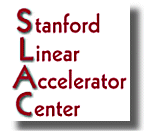| Recent
Advances in Medical Applications of Synchrotron Radiation Stanford Synchrotron Radiation Laboratory March 4-5, 2002 Program Director: Edward Rubenstein |
|
Microbeam
Radiation Therapy at the National Synchrotron Light Source
F. Avraham Dilmanian1, Nan Zhong1, Gerard M. Morris1, 2, Tigran Bacarian1, Alexander Fuchs3, James F. Hainfeld1, John Kalef-Ezra4, Renat Yakupov1, and Eliot M. Rosen3 1Brookhaven National Laboratory, Upton, NY; 2Oxford University, Oxford, UK; 3Long-Island Jewish Medical Center, New Hyde P ark, NY; and 4University of Ioannina, Ioannina, Greece |
| Conventional
radiation therapy has limited success in treating brain tumors because
of its potential damage to the surrounding normal central nervous
system (CNS) tissue. This limitation makes treating high-grade gliomas
palliativ
e rather than curative. Radiation is thought to damage the
normal CNS in part by injuring the microvasculature. Microbeam Radiation
Therapy (MRT) 1-9, an innovative approach to therapy, appears
to address this limitation. MRT, initiated at the National Synchrotron
Light Source (NSLS), BNL, and currently pursued also at the European
Synchrotron Radiation Laboratory (ESRF), Grenoble, France, uses segmented
x-ray bea
ms as parallel, thin (<100 Ám wide) planes of synchrotron-generated
x rays (microplanar beams, or microbeams). Single-exposure unidirectional
MRT is tolerated at in-beam doses up to 10-fold larger than that of
broad-beam irradiation by the normal brains of adult rats1, 2,
weanling rats3, duck embryos4, and piglets5.
All these studies used beam widths of about 27 Ám and beam spacings
of 75-200 Ám on-center. Furthermore, unidirectional MRT preferentially
kills the intracranial rat 9LGS tumor at doses quite tolerated by
the normal brain2, 6, 7. MRT demonstratively has a larger
therapeutic index for 9LGS (ratio of maximum dose tolerated by normal
tissue to minimum dose ablating tumor) than do broad beams7.
MRT's 10-fold advantage in the brain's tolerance for in- beam microbeam doses represents about a 3-fold advantage when the average (or "integrated") dose is used instead, indicating that it is not merely due to the "volume factor" (the ratio of total tissue volume to the volume of in-beam tissue, which was about 3 in the studies)7. Therefore, a biological effect must be involved. We hypothesize that normal-tissue-sparing of MRT is due to the replacement of lethally inju red endothelial cells in the direct microbeam paths with their neighbors surviving between the beams1. This repair may fail in the tumor because of its lesser-developed microvasculature. Studies with the subcutaneous murine mammary carcinoma EMT-6 also revealed a larger therapeutic index for MRT (manuscript submitted). Cross-planar MRT (i.e., two microbeam arrays propagating in the same direction, one with vertical and one with horizontal microplanar beams) way compared to broad-beam irradiations from the same beamline. The beam used was 90-Ám wide with 300-Ám spacing; this wider beam spacing may be important in human studies as it will better accommodate tissue pulsations. In particular, at doses that ablated about 80% of the tumors, i.e., 650 Gy in-beam cross-planar MRT and 45-Gy broad beams, ther e was full hair regrowth in 3/6 mice about two months after MRT, but in none (0/4 ) in the broad-beam group. Research supported by a Laboratory Directed Research and Development grant of BNL, and by the Office of the Biological and Environmental Research, United States Department of Energy. References 1. D. N. Slatkin, et al., Proc. Nat. Acad. Sc i. 92: 8783-8787, 1995. 2. J. A. Laissue, et al., Int. J. Cancer 78: 654-660, 1998. 3. J. A. Laissue, et al., SPIE Conference Proceedings Vol. 3770, pp. 38-45,1999. 4. F. A. Dilmanian, et al., Cell. Molec. Biol. 47: 485-494, 2001. 5. J. A. Laissue, et al., SPIE Conference Proceedings Vol. 4508, pp. 65-73, 2001. 6. D. N. Slatkin, et al., Rev. Sci. Instrum. 65: 1459 -1460, 1995. 7. F. A. Dilmanian, et al., Neuro-Oncol. 4: 26-38, 2002. |



